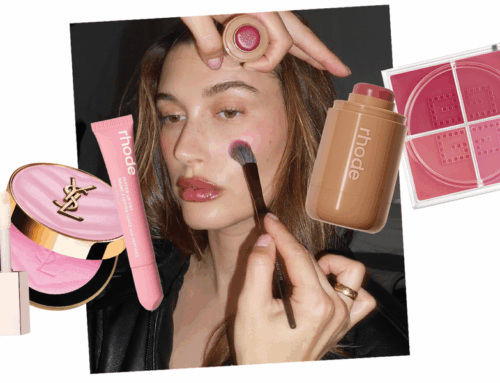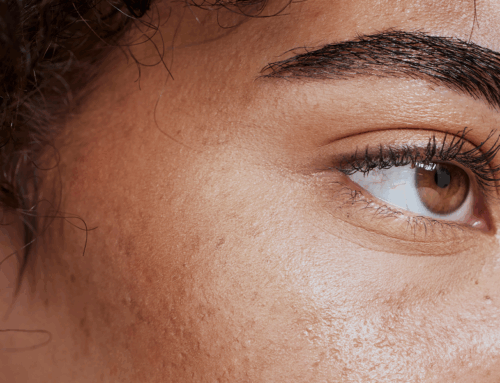As a beauty editor, I’ve lost track of how many times I’ve heard dermatologists refer to tretinoin (aka prescription retinol) as the “gold standard” for treating acne, dark spots, wrinkles—basically anything standing between you and your best skin. I’ve written about it, recommended it, and nodded along knowingly during interviews when doctors waxed poetic about its benefits. So, when my own dermatologist finally handed me a prescription for tretinoin cream nearly a decade ago, I was ready—or so I thought.
In reality, nothing prepared me for those first few weeks. My skin went from mostly balanced to completely bone-dry seemingly overnight, peeling in unpredictable places and turning blotchy if I so much as looked at another active like glycolic or salicylic acid. Makeup refused to sit right, instead just caking on to the raw skin beneath it, and even then, nothing succeeded in truly masking the irritation. I alternated between wondering if I’d made a huge mistake and reassuring myself that this “adjustment period” was just part of the deal.
But slowly, with strategic moisturizing, daily face sunscreen, and a less-is-more approach, my skin stopped staging a 24-7 protest, and by month two, I understood the tretinoin cream hype. The tiny bumps along my jawline disappeared, my sun spots softened, and my skin had that quietly radiant, “I woke up like this” quality you simply can’t bottle. It wasn’t instant magic, but it was worth every awkward, flaky second along the way.
That’s the thing about tretinoin: it’s powerful, effective, and genuinely transformative, but it’s also not a product you can just slap on every night and forget about by the time your head hits the pillow. It’s a prescription-strength retinoid that demands patience, consistency, and a little bit (read: a lot) of strategy. If you’re thinking about trying it, you’ll want to know exactly what it does, how it’s different from over-the-counter retinol, and how to avoid the rookie mistakes that can send you running for the nearest jar of Aquaphor and ultimately missing out on tretinoin’s myriad benefits. Ahead, we (aka me, a veteran tretinoin user and four expert dermatologists) to answer the most common tretinoin questions so you can decide if this skincare legend deserves a spot in your own lineup.
What does tretinoin cream do?
The better question might just be: What doesn’t it do? Tretinoin isn’t just a one-trick pony; it’s the ultimate overachiever of the skincare world. “It speeds up skin cell turnover, unclogs pores, and boosts collagen production, and it’s used for treating acne, reducing fine lines and wrinkles, fading dark spots, melasma, and sun damage,” explains Gabriela Soza, MD, a board-certified dermatologist in Dallas, Texas. “It also improves overall skin texture, helping make your skin more youthful—both in actuality, like if you were to examine it under the microscope, and in appearance.”
In other words, this is one of the rare skincare ingredients that works on both the surface and deep in the skin, which is exactly why dermatologists love it. “Incorporating a retinoid product is one of the most important steps you can take in addition to regular sunscreen use and antioxidants,” adds Corey L. Hartman, MD, a board-certified dermatologist in Birmingham, Alabama. “The benefits are unparalleled.”
Is tretinoin the same as retinol cream?
Although both tretinoin and retinol cream are in the vitamin A family, they’re far from interchangeable. Think of tretinoin as more of a direct flight compared to retinol’s three layovers; both will get you to your final destination, but the first is considerably more efficient. “Tretinoin is pure retinoic acid, the active form your skin can use immediately, no conversion required,” says Dr. Soza. “Over-the-counter retinol, on the other hand, must first be converted by your skin into retinoic acid, so it’s weaker and works more slowly, but is also gentler and easier to tolerate. Because of this, tretinoin works faster and gives more dramatic results, but with a higher chance of irritation.”
And while tretinoin is prescription-only in the U.S., it’s not always the more expensive route. “Prescription retinoids have historically been pricier; however, that has changed and they’re now affordable with the widespread use of compounding pharmacies and coupons, like GoodRx,” says Dr. Soza. “OTC retinols should be affordable, but many skincare brands unnecessarily mark them up, making them more expensive than their more effective prescription counterparts.”
What are the side effects of tretinoin?
When you first start tretinoin, expect some bumps in the road, literally. Dryness, peeling, redness, and mild stinging are common in the first four to eight weeks as your skin adjusts. “Tretinoin may cause skin irritation, including redness, dryness, and skin sensitivity,” says Marisa Garshick, MD, a board-certified dermatologist in New York City. “In some cases, people may experience a purge or a slight worsening in breakouts within the first few weeks.”
That “purge” isn’t a reason to quit though. “It’s simply cell turnover bringing any lingering acne to the surface more quickly,” says Dr. Gabriele Soza. “We use tretinoin to treat acne, so any uptick is temporary and worth pushing through.” Think of it like clearing out a closet: it might look messier before it looks better. However, you can minimize discomfort by starting slow (two to three nights per week), applying a pea-sized amount for your entire face, and pairing it with a moisturizer before and after (a layering trick known as the “moisturizer sandwich”). And don’t forget to apply SPF every morning. Tretinoin can make your skin more sensitive to the sun, so UV protection is non-negotiable if you want to keep irritation low and results high.
Can you use tretinoin under eyes?
Yes—but this is a proceed-with-caution situation. “While tretinoin may be used under the eyes, it may be a little harsh for the delicate undereye skin, so a specific retinol intended for the eye area may be preferred,” says Dr. Garshick.
If you want to try it, be sure to start with the gentlest approach possible. “Begin with a low concentration and only lightly sweep the product toward the bony part around the eye, never directly on the lash line,” recommends Rishi Chopra, MD, a board-certified dermatologist in New York, New York. “Mixing it with a moisturizer or using the ‘sandwich’ method can help buffer the skin and reduce irritation.”
Can I buy tretinoin cream over the counter?
For better or worse, tretinoin is not something you can just toss in your Sephora cart in the U.S. “Tretinoin requires a prescription,” says Dr. Garshick. “This ensures you get the right strength and formulation for your skin and the proper guidance for using it safely.”
That prescription-only status isn’t just gatekeeping; it’s because tretinoin is potent, can cause irritation if misused, and needs to be tailored to your skin type, concerns, and tolerance. A dermatologist can also help you decide whether you should start with tretinoin right away or try a gentler OTC retinol first to build tolerance. But the good news is that with the rise of teledermatology and compounding pharmacies, getting a prescription has never been easier (or in many cases, more affordable).
Is it good to use tretinoin every day?
The end goal for many people using tretinoin is nightly use, but you should never start there—that is, unless you’re into voluntarily turning your face into sandpaper. “I have my patients start with once a week, adding a night each week until nightly,” says Dr. Soza. “Some patients find their sweet spot is three nights a week and still see great results.” Dr. Hartman agrees that frequency is a very personal matter. “Many people can use tretinoin daily, but if you are new to using it, I advise starting it twice a week to get your skin acclimated,” he says. “Once your skin successfully tolerates twice a week, start to increase to three or four times per week and continue.” And if your skin never quite loves nightly use? That’s fine; consistency over time matters more than hitting seven nights a week.
Who should avoid tretinoin?
Pregnant people should avoid tretinoin completely, as studies have linked high-dose vitamin A derivatives to birth defects. “Tretinoin should be avoided during pregnancy,” says Dr. Garshick, adding that those with rosacea, eczema, or very sensitive skin should also use caution. Dr. Chopra notes that timing is everything: “If you have a compromised skin barrier—from a sunburn, eczema flare, or certain cosmetic treatments—wait until it’s fully healed before starting tretinoin.” And if you’re unsure, a dermatologist can help you decide whether now is the right time to begin, or whether your skin would benefit from building tolerance with OTC retinol first.
Is tretinoin gel or cream better?
Both work equally well in terms of results, but they differ in how they feel and who they suit best. “Tretinoin gel is good for those with oily skin, while tretinoin cream is preferred for those with dry or sensitive skin,” says Dr. Garshick. The gel’s lighter texture can feel less greasy and may absorb faster, but it can also be more drying. The cream, meanwhile, tends to be more hydrating and is often better tolerated by sensitive or mature skin.
Dr. Hartman often matches the formula to the patient’s main goal. “Creams tend to be my choice for addressing aging concerns like wrinkling and hyperpigmentation, and I tend to recommend a gel for patients with acne concerns,” he says. If you’re not sure, your dermatologist may even switch your formula seasonally—cream in the winter, gel in the summer—to keep your skin happy year-round.
Meet the experts:
- Dr. Gabriela Soza is a board-certified dermatologist at SozaMD in Dallas, Texas, and at PFRANKMD in New York City. She specializes in cosmetic and medical treatments, from acne and melasma to hair loss and skin tightening.
- Dr. Corey L. Hartman is a board-certified dermatologist and the founder of Skin Wellness Dermatology in Birmingham, AL, and an assistant clinical professor at the University of Alabama School of Medicine. With two decades of experience, he’s known for his expertise in cosmetic dermatology, laser treatments, and hair restoration.
- Dr. Rishi Chopra is a board-certified dermatologist at Union Derm in New York City. He is known for his work with lasers, injectables, and skincare for diverse skin tones, and he has authored over 30 peer-reviewed publications and frequently lectures at top industry conferences.
- Dr. Marisa Garshick is a board-certified dermatologist at MDCS Dermatology in New York City. She’s known for her expertise in both medical and cosmetic dermatology, including eczema, psoriasis, fillers, and chemical peels.
Why trust Cosmo?
Gabby Shacknai is a New York City–based journalist with years of experience researching, writing, and editing beauty and wellness stories. Gabby is an authority in all beauty categories but an expert when it comes to skincare and cosmetic treatments. She regularly works with the industry’s top dermatologists and plastic surgeons to assess new brands, treatments, trends, and technologies.
Gabby Shacknai is a New York-based journalist and editor who produces high-quality content for a wide variety of outlets and brands across various industries.








